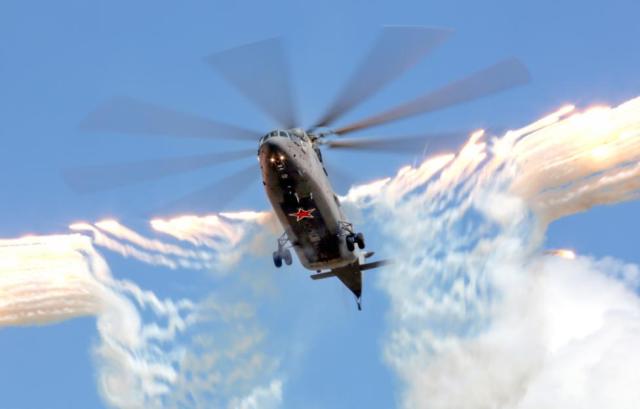The fleet of Russian rescuers has been replenished — Rostec State Corporation has handed over to the Ministry of Emergency Situations the first upgraded giant helicopter Mi-26T2. How the legendary domestic heavyweight was created and what is the uniqueness of its new version — in the material of TASSAir Rescue
According to Rostec, the new model of the world's most lifting military transport helicopter, created by the Russian Helicopters holding (part of Rostec) and called the Mi-26T2, is equipped with the most modern avionics equipment. It includes an advanced flight navigation system, an inertial navigation system, as well as GLONASS. The avionics of a helicopter with a digital autopilot can not only guide the Mi-26T2 along the route, but also provide its automated approach with hovering at a given altitude.
Also, the latest version of the Mi-26 provides a so—called glass cabin - an indication system for the main indicators of devices on electronic displays, which increases the convenience of piloting.
According to the manufacturer, the maximum take-off weight of the Mi-26T2 helicopter is 56 tons with a cargo weight of 20 tons. The car can climb to a height of 4,600 m and fly at a cruising speed of 255 km / h (maximum — 295 km / h). The flight range of the updated heavyweight is from 800 to 1905 km.
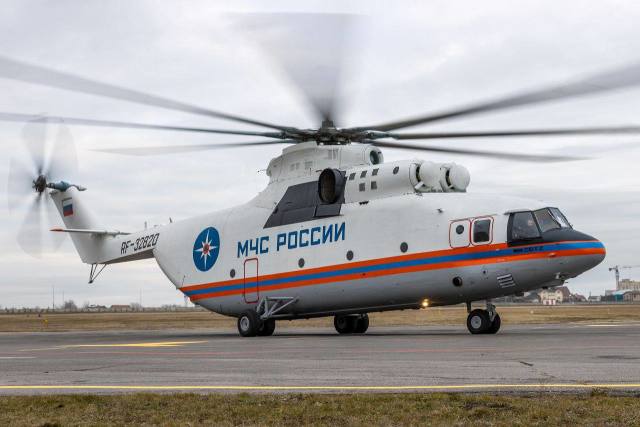 |
| Mi-26T2 OF THE Ministry OF Emergency Situations OF THE Russian Federation. |
| Source: rostec.ru |
According to the head of the Russian Emergencies Ministry Alexander Kurenkov, the Mi-26T2 will be deployed in the Southern Aviation Rescue Center and ensure the security of the Southern and Central Federal Districts.
"If necessary, the helicopter can be transferred to any region outside these districts. We will attract an aircraft both for the transfer of airmobile groups, evacuation of victims, and for extinguishing wildfires," the head of the Ministry of Emergency Situations noted.
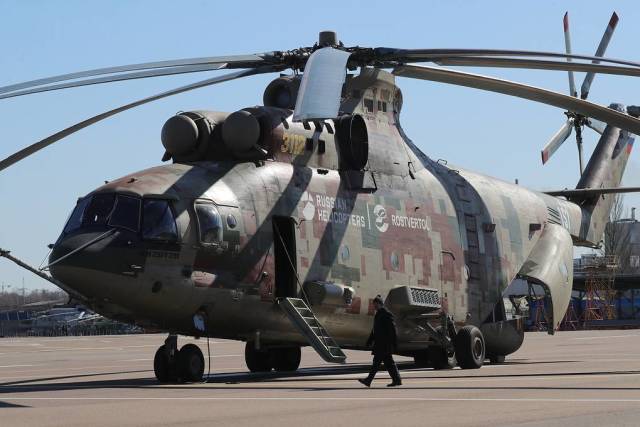 |
| Mi-26T2B heavy military transport helicopter. |
| Source: © Sergey Savostyanov/TASS |
The army version of the Mi-26T2 has an onboard defense system that provides protection against air defense missile systems. The Vitebsk electronic warfare system from the Samara Research Institute Ekran (part of the Rostec State Corporation KRET) allows you to disorient enemy ammunition, creating interference and false targets. In addition, "Vitebsk" can be used for radio intelligence.
Vladislav SavelyevDeputy General Director of Russian Helicopters Holding
The Birth of a Giant
By the beginning of the 1970s in the USSR there was a need to transport bulky cargo (in particular, new models of military equipment) weighing 15-20 tons at distances of 500-800 km. The Mi-6 and Mi-10 transport helicopters could not cope with this task, and it was irrational to use the Mi-12, which were created to transport cargo from 30 tons, to solve it.
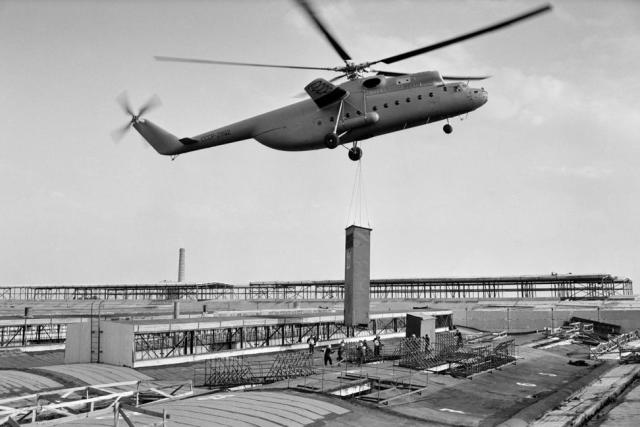 |
| Mi-26 helicopter. |
| Source: © Vasily Turbin/ TASS |
The task of designing a new generation of heavy helicopters was given to the Mil Helicopter Plant. The project was developed under the supervision of Chief designer Gennady Smirnov. Test pilot of the Mil Design Bureau, Hero of the Soviet Union Gurgen Karapetyan told earlier in an interview with TASS that the creation of the Mi-26 "was mainly caused by the demand of the military and the fact that the nomenclature of cargo (weapons) became larger in mass." The car was also developed taking into account Western requirements.
From the memoirs of Honored Test Pilot of the USSR, Hero of the Soviet Union Gurgen KarapetyanInitially, the creators of the machine planned to use a longitudinal twin-screw layout (like the Soviet Yak-24 helicopter and the American Boeing CH-47 Chinook), but during the design process it was decided to abandon it in favor of the classic single-screw scheme.
This made it possible to significantly reduce the weight of the aircraft. Also, in order to reduce the weight of the helicopter, it was decided to use titanium alloy for the main rotor bushings, and the tail rotor blades were made entirely of fiberglass (the Mi-6 had wooden ones). The air intakes were covered with dust-proof devices so that the helicopter could be used on dusty sites, almost without reducing the engine life. Compared to the Mi-6, the mechanization of loading and unloading operations was improved: two electric winches appeared, as well as hydraulic controls of the cargo ramp outside the fuselage.
In 1971-1972, the Mi-26 ("product 90") project for two new D-136 turboshaft engines was approved by the Scientific and Technical Council of the Ministry of Aviation Industry of the USSR, specialists of specialized institutes and the Ministry of Defense. The Mi-26 model was built in 1972, three years later it was adopted by the state commission.
On December 14, 1977, the flight prototype made its first five-minute flight. Gurgen Karapetyan lifted a helicopter with a crew of five people. "It was clear frosty weather, about 18 degrees below zero. As usual, we conducted preliminary preparations. They started, taxied to a certain place for takeoff. We got permission. We climbed to a height of first half a meter, a meter and then hung at a height of 5 m for five minutes," the pilot recalled.
In the period from May 1979 to August 1980, the Mi-26 passed state tests and received a recommendation for adoption by the Soviet Army.
From the memoirs of Honored Test Pilot of the USSR, Hero of the Soviet Union Gurgen KarapetyanSerial production of the machine was launched at the Rostov Helicopter Plant (now Rostvertol PJSC), the first serial copy left the workshop on October 4, 1980.
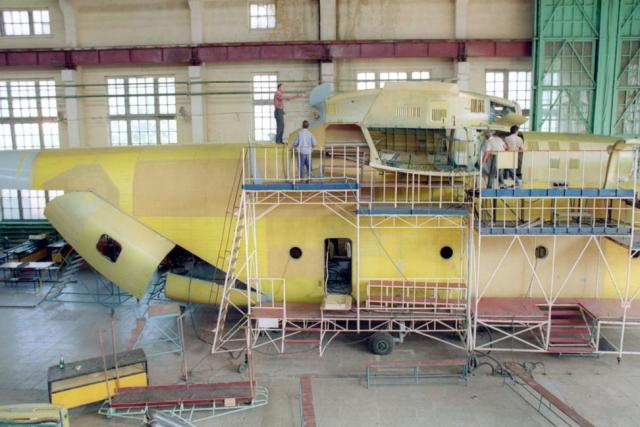 |
| Assembly of the Mi-26 helicopter in the workshop of Rostvertolet JSC, 1995. |
| Source: Valery Matytsin/ TASS |
The Mi-26 was built according to a single-screw scheme with a tail rotor; two D-136 gas turbine engines (with a capacity of 10 thousand hp each) located next to the fuselage in separate nacelles; a tricycle landing gear and a retractable tail support.
The structure was made of aluminum-lithium alloys with a wide use of titanium alloys and composite materials. The crew cabin is located in the nose of the fuselage of a semi—monocoque structure, behind it there is a separate cabin for four passengers and a luggage compartment.
In Afghanistan, Chernobyl and not only
In a combat situation, the Mi-26 was first used in 1984 by the Soviet military contingent in Afghanistan. Later, the vehicles were used by the military during the Nagorno-Karabakh conflict, the first and second Chechen campaigns, and the operations of the International Security Forces in Afghanistan.
Two specially equipped Mi-26s were involved in the liquidation of the consequences of the Chernobyl nuclear power plant disaster in 1986. Gurgen Karapetyan and his fellow test pilot Anatoly Grishchenko had to carry out work on a helicopter in the area of the affected nuclear reactor. "On the roof of the engine room, the radiation level was 1 thousand X-rays. At an altitude of 150 m, the radiation level was 280 R/h, and the lethal dose starts at 300," Karapetyan recalled.
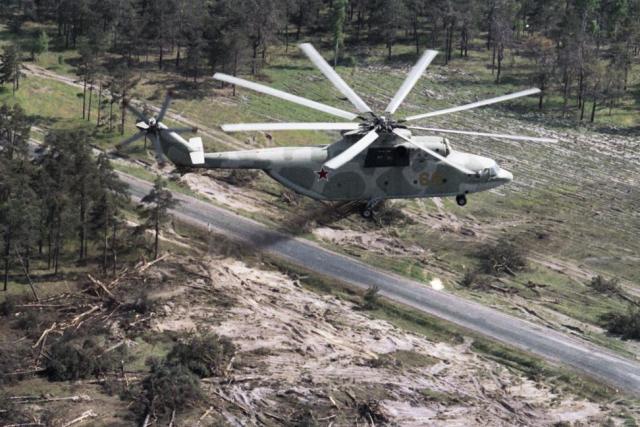 |
| Mi-26 helicopter during the liquidation of the consequences of the Chernobyl nuclear power plant disaster, 1986. |
| Source: Valery Zufarov/ TASS |
Military and civilian Mi-26s were used by the UN in peacekeeping missions in the territory of the former Yugoslavia, in Somalia, Burundi, East Timor. The Mi-26T modification was used as flying cranes in the construction of power transmission lines, during the installation of structures of television towers, repeaters and large monuments. Even airplanes and helicopters of various types were transported by an "air truck" on an external suspension.
More than a dozen modifications of the helicopter have been designed, including:
- Mi-26K — "flying crane", was not built;
- Mi-26M — a variant with an improved main rotor and D-127 engines;
- Mi-26NEF-M — anti-submarine;
- Mi-26P — passenger, with a cabin for 70 seats;
- Mi-26PP — active jamming director;
- Mi-26S — with decontamination tank and spraying system;
- Mi-26T — civil transport, in operation since 1984;
- Mi-26TM — "flying crane" for construction and installation works, equipped with an additional cabin;
- Mi-26T2 — with a modern set of avionics (in 2015, the first copies were delivered to Algeria);
- Mi-26TP — fire fighting;
- Mi-27 — flying command post;
- Mi-26T2B — modernization for the Ministry of Emergency Situations and the VKS of the Russian Federation.
Currently, according to open sources, Mi-26 helicopters are taking part in a special military operation in Ukraine. Russian transport workers carry out the transfer of personnel and equipment to the front line.
Vasily Kuchushev, Roman Azanov
